A Study on the Dynamic Response and Deformation of Slopes Supported by Anti-Slide Piles Subjected to Seismic Waves with Different Spectral Characteristics
Abstract
:1. Introduction
2. Numerical Simulation Scheme
2.1. Establishing the Numerical Model
2.2. Boundary Conditions
2.3. Numerical Simulation Conditions
3. Results
3.1. Analysis of the Dynamic Response of an Anti-Slide Pile
3.1.1. Effect of Seismic-Wave Frequency on the Dynamic Response of an Anti-Slide Pile
3.1.2. Effect of Seismic-Wave Amplitude on the Dynamic Response of an Anti-Slide Pile
3.1.3. Effect of Seismic-Wave Duration on the Dynamic Response of an Anti-Slide Pile
3.2. Analysis of the Dynamic Response of the Slope
3.2.1. Effect of Seismic-Wave Frequency on the Dynamic Response of the Slope
3.2.2. Effect of Seismic-Wave Amplitude on the Dynamic Response of the Slope
3.2.3. Effect of Seismic-Wave Duration on the Dynamic Response of the Slope
4. Discussion
4.1. Correlation Analysis of the Dynamic Response of the Anti-Slide Pile–Slope System
4.2. Time–Frequency Analysis of the Dynamic Response of the Slope
5. Conclusions
Author Contributions
Funding
Institutional Review Board Statement
Informed Consent Statement
Data Availability Statement
Conflicts of Interest
References
- Yin, Y.; Zhang, Y.; Ma, Y.; Hu, D.; Zhang, Z. Research on major characteristics of geohazards induced by the Yushu Ms 7.1 earthquake. J. Eng. Geol. 2010, 18, 289–296. [Google Scholar] [CrossRef]
- Li, Y.; Cui, P.; Ye, C.; Junior, J.M.; Zhang, Z.; Guo, J.; Li, J. Accurate Prediction of Earthquake-Induced Landslides Based on Deep Learning Considering Landslide Source Area. Remote Sens. 2021, 13, 3436. [Google Scholar] [CrossRef]
- Xiong, M.; Huang, Y. Stochastic seismic response and dynamic reliability analysis of slopes: A review. Soil. Dyn. Earthq. Eng. 2017, 100, 458–464. [Google Scholar] [CrossRef]
- Wu, H.G.; Pai, L.F. Shaking table test for reinforcement of soil slope with multiple sliding surfaces by reinforced double-row anti-slide piles. J. Mt. Sci. 2022, 19, 1419–1436. [Google Scholar] [CrossRef]
- Li, D.Q.; Jiang, S.H.; Cao, Z.J.; Zhou, C.B.; Li, X.Y.; Zhang, L.M. Efficient 3-D reliability analysis of the 530 m high abutment slope at Jinping I Hydropower Station during construction. Eng. Geol. 2015, 195, 269–281. [Google Scholar] [CrossRef]
- Chen, H.R.; Qin, S.Q.; Xue, L.; Yang, B.C.; Zhang, K. Universal precursor seismicity pattern before locked-segment rupture and evolutionary rule for landmark earthquakes. Geosci. Front. 2022, 13, 101314. [Google Scholar] [CrossRef]
- Jiang, X.; Fu, Y.; Jiang, J.; Li, J. Spatial distribution of the earthquake in Mainland China. Physica A. 2019, 530, 120941. [Google Scholar] [CrossRef]
- Wu, G.; Tan, H.; Zou, Z.; Yang, G.; Shen, C. Gravity distribution characteristics and their relationship with the distribution of earthquakes and tectonic units in the North–South seismic belt, China. Geod. Geodyn. 2015, 6, 194–208. [Google Scholar] [CrossRef]
- Gorum, T.; Fan, X.; van Westen, C.J.; Huang, R.Q.; Xu, Q.; Tang, C.; Wang, G. Distribution pattern of earthquake-induced landslides triggered by the 12 May 2008 Wenchuan earthquake. Geomorphology 2010, 133, 152–167. [Google Scholar] [CrossRef]
- Tang, C.; Zhu, J.; Qi, X.; Ding, J. Landslides induced by the Wenchuan earthquake and the subsequent strong rainfall event: A case study in the Beichuan area of China. Eng. Geol. 2011, 122, 22–33. [Google Scholar] [CrossRef]
- Chen, S.; Hua, J.; Liu, W.; Yang, S.; Wang, X.; Ji, W. Effects of Artificial Restoration and Natural Recovery on Plant Communities and Soil Properties across Different Temporal Gradients after Landslides. Forests 2023, 14, 1974. [Google Scholar] [CrossRef]
- Duan, C.S.; Zhang, Q.J.; Gong, X.; Zhang, Y.B. Evaluation of plant community and soil recovery in earthquake landslide. Act. Ecol. Siica 2020, 40, 6584–6596. [Google Scholar] [CrossRef]
- Xu, M.; Tang, Y.; Liu, X.; Yang, H.; Luo, B. A shaking table model test on a rock slope anchored with adaptive anchor cables. Int. J. Rock. Mech. Min. 2018, 112, 201–208. [Google Scholar] [CrossRef]
- Shi, K.; Wu, X.; Liu, Z.; Dai, S. Coupled calculation model for anchoring force loss in a slope reinforced by a frame beam and anchor cables. Eng. Geol. 2019, 260, 105245. [Google Scholar] [CrossRef]
- Faiz, H.; Ng, S.; Rahman, M. A state-of-the-art review on the advancement of sustainable vegetation concrete in slope stability. Constr. Build. Mater. 2022, 326, 126502. [Google Scholar] [CrossRef]
- Pushkarev, A.; Sokolov, N.; Mihailov, A. Methods and technology of reinforcing a leaning slope. Transp. Res. Proce. 2021, 57, 538–546. [Google Scholar] [CrossRef]
- Xu, C.; Xue, L.; Cui, Y.; Guo, S.; Zhai, M.; Bu, F. A New Multi-Objective Comprehensive Optimization Model for Homogeneous Slope Reinforced by Anti-Slide Piles: Insights from Numerical Simulation. Lithosphere 2022, 2022, 6499724. [Google Scholar] [CrossRef]
- Tang, H.; Gong, W.; Wang, L.; Juang, C.H.; Martin, J.R.; Li, C.D. Multi-objective optimization-based design of stabilizing piles in earth slopes. Int. J. Numer. Anal. Met. 2019, 43, 1516–1536. [Google Scholar] [CrossRef]
- Lian, J.; Ding, X.; Wen, H.; Tong, X.; Qu, L. Dynamic responses and evolution characteristics of bedrock and overburden layer slope with space anchor cable anti-slide piles based on large-scale shaking table test. Soil. Dyn. Earthq. Eng. 2023, 175, 108245. [Google Scholar] [CrossRef]
- Liu, X.; Cai, G.; Liu, L.; Zhou, Z. Investigation of internal force of anti-slide pile on landslides considering the actual distribution of soil resistance acting on anti-slide piles. Nat. Hazards. 2020, 102, 1369–1392. [Google Scholar] [CrossRef]
- Mao, W.; Liu, B.; Rasouli, R.; Aoyama, S.; Towhata, I. Performance of piles with different configurations subjected to slope deformation induced by seismic liquefaction. Eng. Geol. 2019, 263, 105355. [Google Scholar] [CrossRef]
- Xu, X.; Huang, Y. Parametric study of structural parameters affecting seismic stability in slopes reinforced by pile-anchor structures. Soil. Dyn. Earthq. Eng. 2021, 147, 106789. [Google Scholar] [CrossRef]
- Wang, L.; Sun, D.; Yao, Y.; Tan, Y. Seismic stability of 3D piled unsaturated earth slopes using kinematic limit analysis. Soil. Dyn. Earthq. Eng. 2019, 126, 105821. [Google Scholar] [CrossRef]
- Ma, N.; Wu, H.; Ma, H.; Wu, X.; Wang, G. Examining dynamic soil pressures and the effectiveness of different pile structures inside reinforced slopes using shaking table tests. Soil. Dyn. Earthq. Eng. 2019, 116, 293–303. [Google Scholar] [CrossRef]
- Xue, L.; Li, L.; Xu, C.; Cui, Y.; Ding, H.; Huang, K.; Li, Z. A multi-objective optimization evaluation model for seismic performance of slopes reinforced by pile-anchor system. Sci. Rep. 2024, 14, 5044. [Google Scholar] [CrossRef]
- Qi, S.; He, J.; Zhan, Z. A single surface slope effects on seismic response based on shaking table test and numerical simulation. Eng. Geol. 2022, 306, 106762. [Google Scholar] [CrossRef]
- Wu, M.; Liu, F.; Yang, J. Seismic response of stratified rock slopes due to incident P and SV waves using a semi-analytical approach. Eng. Geol. 2022, 301, 106594. [Google Scholar] [CrossRef]
- Maheshwari, B.K.; Truman, K.Z.; Naggar, M.H.E.; Gould, P.L. Three-dimensional finite element nonlinear dynamic analysis of pile groups for lateral transient and seismic excitations. Can. Geotech. J. 2004, 41, 118–133. [Google Scholar] [CrossRef]
- Chatterjee, K.; Choudhury, D.; Poulos, H.G. Seismic analysis of laterally loaded pile under influence of vertical loading using finite element method. Comput. Geotech. 2015, 67, 172–186. [Google Scholar] [CrossRef]
- Wang, W.; Li, D.Q.; Liu, Y.; Du, W. Influence of ground motion duration on the seismic performance of earth slopes based on numerical analysis. Soil. Dyn. Earthq. Eng. 2021, 143, 106595. [Google Scholar] [CrossRef]
- Pai, L.F.; Wu, H.G.; Guan, W.; Wei, H.; Tang, L. Shaking table test for seismic optimization of soil slope reinforced by new EPS pile under earthquake. Soil. Dyn. Earthq. Eng. 2022, 154, 107140. [Google Scholar] [CrossRef]
- Kuhlemeyer, R.L.; Lysmer, J. Finite element method accuracy for wave propagation problems. ASCE Soil. Mech. Found. Div. J. 1973, 99, 421–427. [Google Scholar] [CrossRef]
- Itasca Consulting Group. FLAC3D 6.0 Modelling; Itasca Consulting Group: Minneapolis, MN, USA, 2017; 405p. [Google Scholar]
- Ma, Z.; Liao, H.; Dang, F.; Cheng, Y. Seismic slope stability and failure process analysis using explicit finite element method. Bull. Eng. Geol. Environ. 2021, 80, 1287–1301. [Google Scholar] [CrossRef]
- Buah, P.A.; Zhang, Y.; He, J.; Yu, P.; Xiang, C.; Fu, H.; He, Y.; Liu, J. Evaluating the dynamic response and failure process of a rock slope under pulse-like ground motions. Geomat. Nat. Haz Risk. 2023, 14, 1. [Google Scholar] [CrossRef]
- GB 50111-2006; Code for Seismic Design of Railway Engineering. China Planning Press: Beijing, China, 2009.
- Lin, Y.L.; Cheng, X.M.; Yang, G.L. Shaking table test and numerical simulation on a combined retaining structure response to earthquake loading. Soil. Dyn. Earthq. Eng. 2018, 108, 29–45. [Google Scholar] [CrossRef]
- Pai, L.F.; Wu, H.G. Shaking table test of comparison and optimization of seismic performance of slope reinforcement with multi-anchor piles. Soil. Dyn. Earthq. Eng. 2021, 145, 106737. [Google Scholar] [CrossRef]
- Dong, J.; Wang, C.; Huang, Z.; Yang, J.; Xue, L. Shaking Table Model Test to Determine Dynamic Response Characteristics and Failure Modes of Steep Bedding Rock Slope. Rock. Mech. Rock. Eng. 2022, 55, 3645–3658. [Google Scholar] [CrossRef]
- Zang, M.; Yang, G.; Dong, J.; Qi, S.; He, J.; Liang, N. Experimental study on seismic response and progressive failure characteristics of bedding rock slopes. J. Rock. Mech. Geotech. 2022, 14, 1394–1405. [Google Scholar] [CrossRef]
- Song, D.; Chen, Z.; Chao, H.; Ke, Y.; Nie, W. Numerical study on seismic response of a rock slope with discontinuities based on the time-frequency joint analysis method. Soil. Dyn. Earthq. Eng. 2020, 133, 106112. [Google Scholar] [CrossRef]
- Chen, G.; Yang, C.; Qu, L.; Tong, X.; Zhang, K.; Zhang, L. Shaking table test and numerical analysis of dynamic response and damage mechanism of a deposit slope with a weak interlayer reinforced by a pile–anchor structure. Structures 2024, 59, 105728. [Google Scholar] [CrossRef]
- Xu, B.; Liu, X.; Zhou, X.; Liang, Y.; Cai, P.; Han, Y.; Huang, J. Investigation of the Dynamic Response Pattern and Instability Mechanism of a Bedding Rock Slope Subjected to Frequent Seismic Loads. Int. J. Geomech. 2024, 24, 04024117. [Google Scholar] [CrossRef]
- Wang, L.; Shi, W.; Zhou, Y. Adaptive-passive tuned mass damper for structural aseismic protection including soil–structure interaction. Soil. Dyn. Earthq. Eng. 2022, 158, 107298. [Google Scholar] [CrossRef]
- Wang, L.; Shi, W.; Li, X.; Zhang, Q.; Zhou, Y. An adaptive-passive retuning device for a pendulum tuned mass damper considering mass uncertainty and optimum frequency. Struct. Control Hlth. 2019, 26, e2377. [Google Scholar] [CrossRef]
- Song, D.; Chen, Z.; Ke, Y.; Nie, W. Seismic response analysis of a bedding rock slope based on the time-frequency joint analysis method: A case study from the middle reach of the Jinsha River, China. Eng. Geol. 2020, 274, 105731. [Google Scholar] [CrossRef]
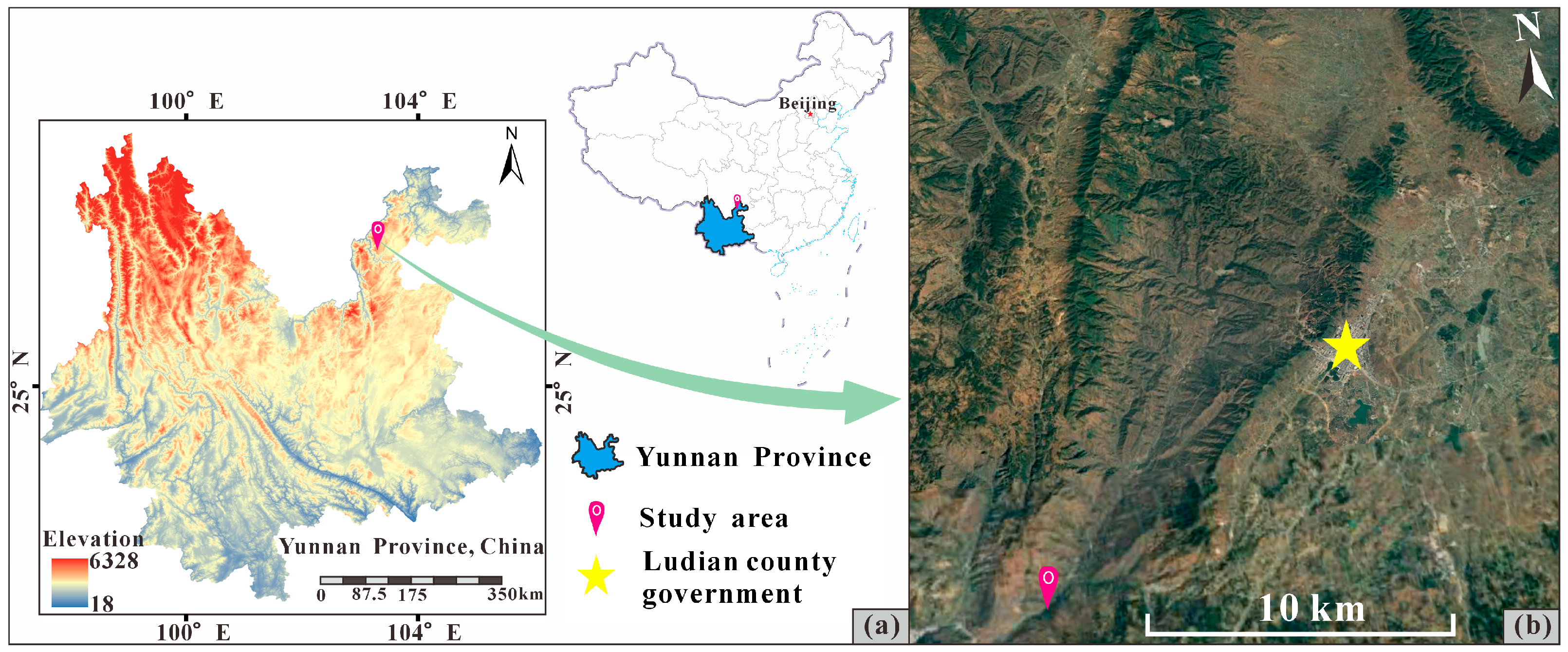
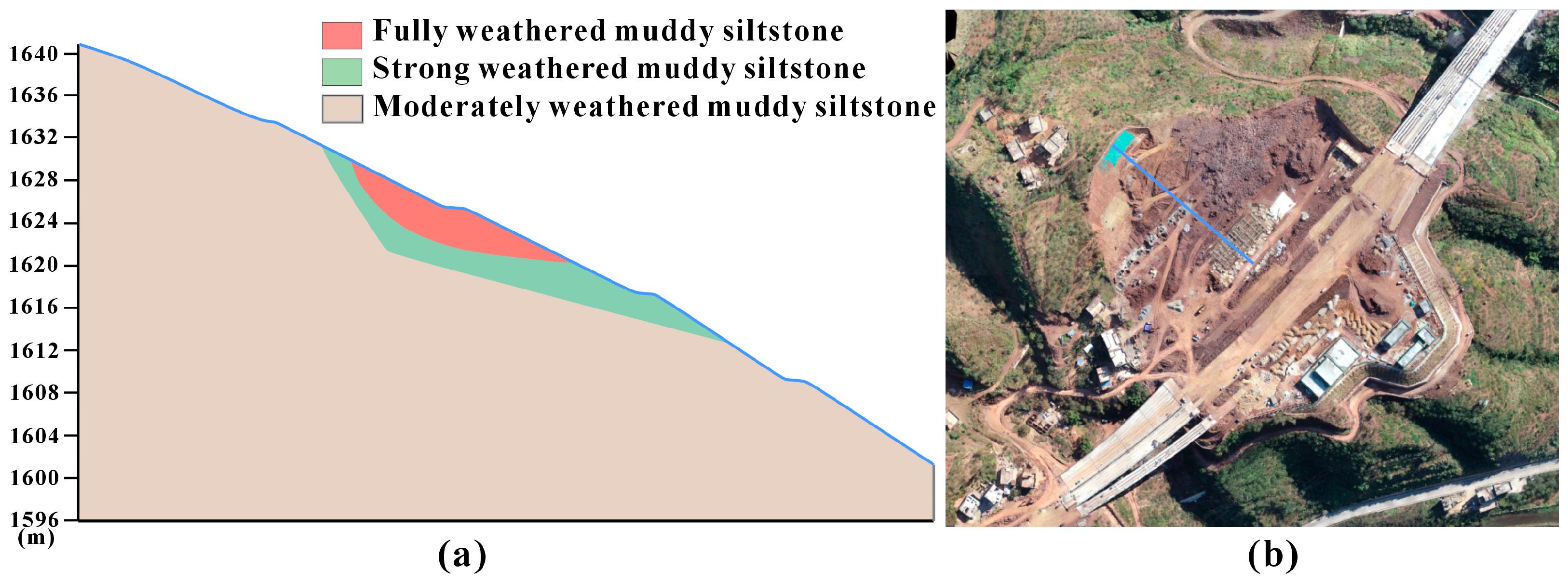
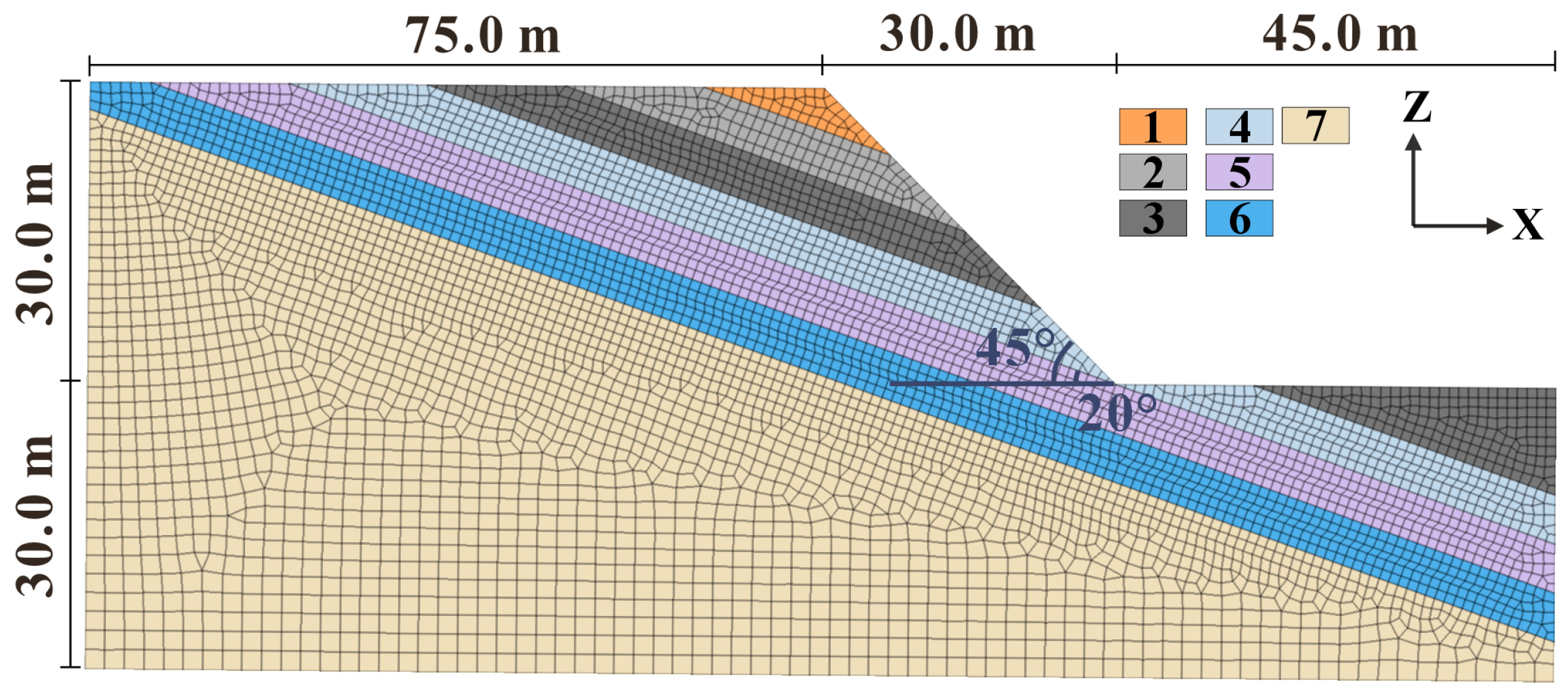
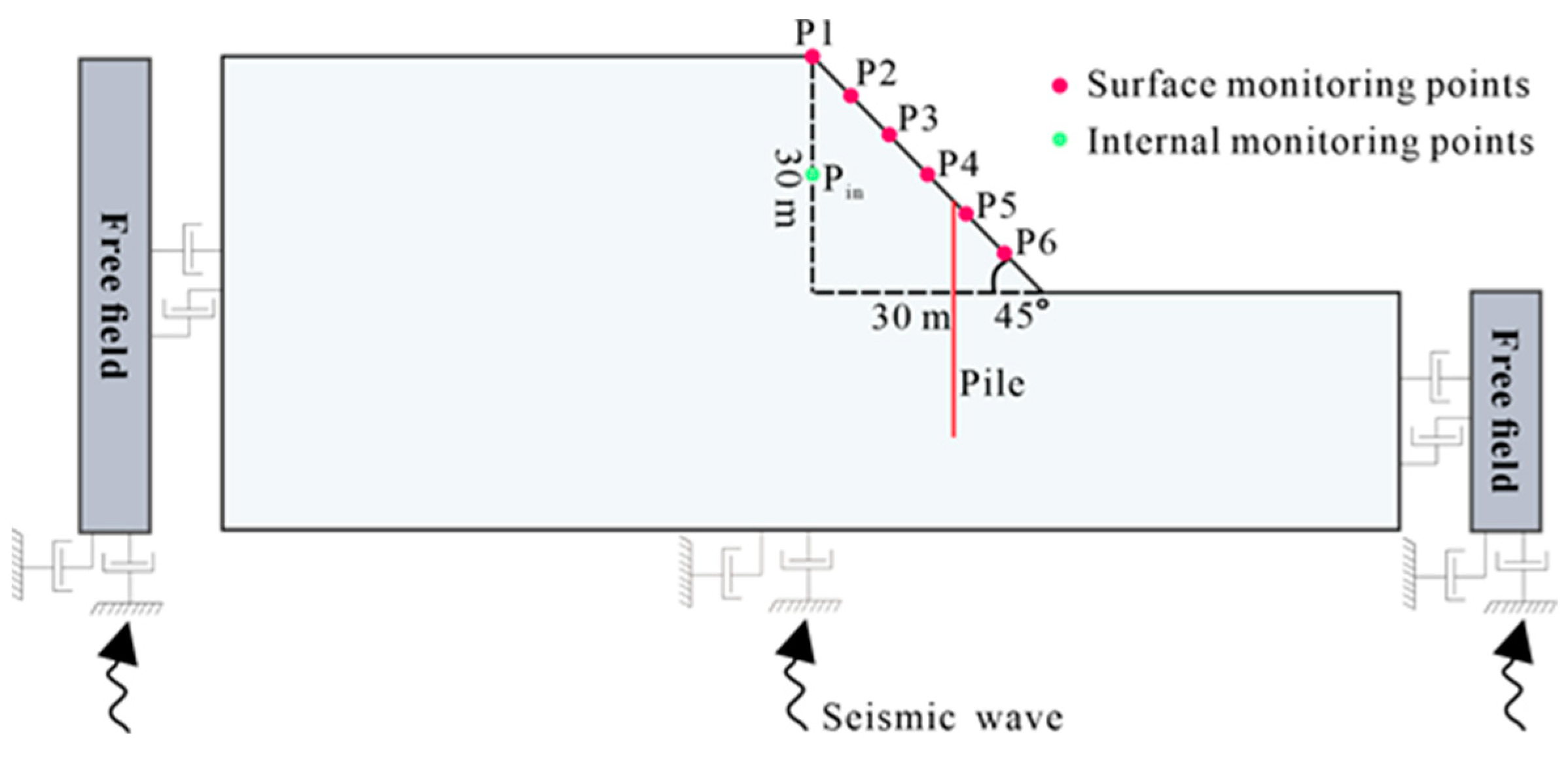
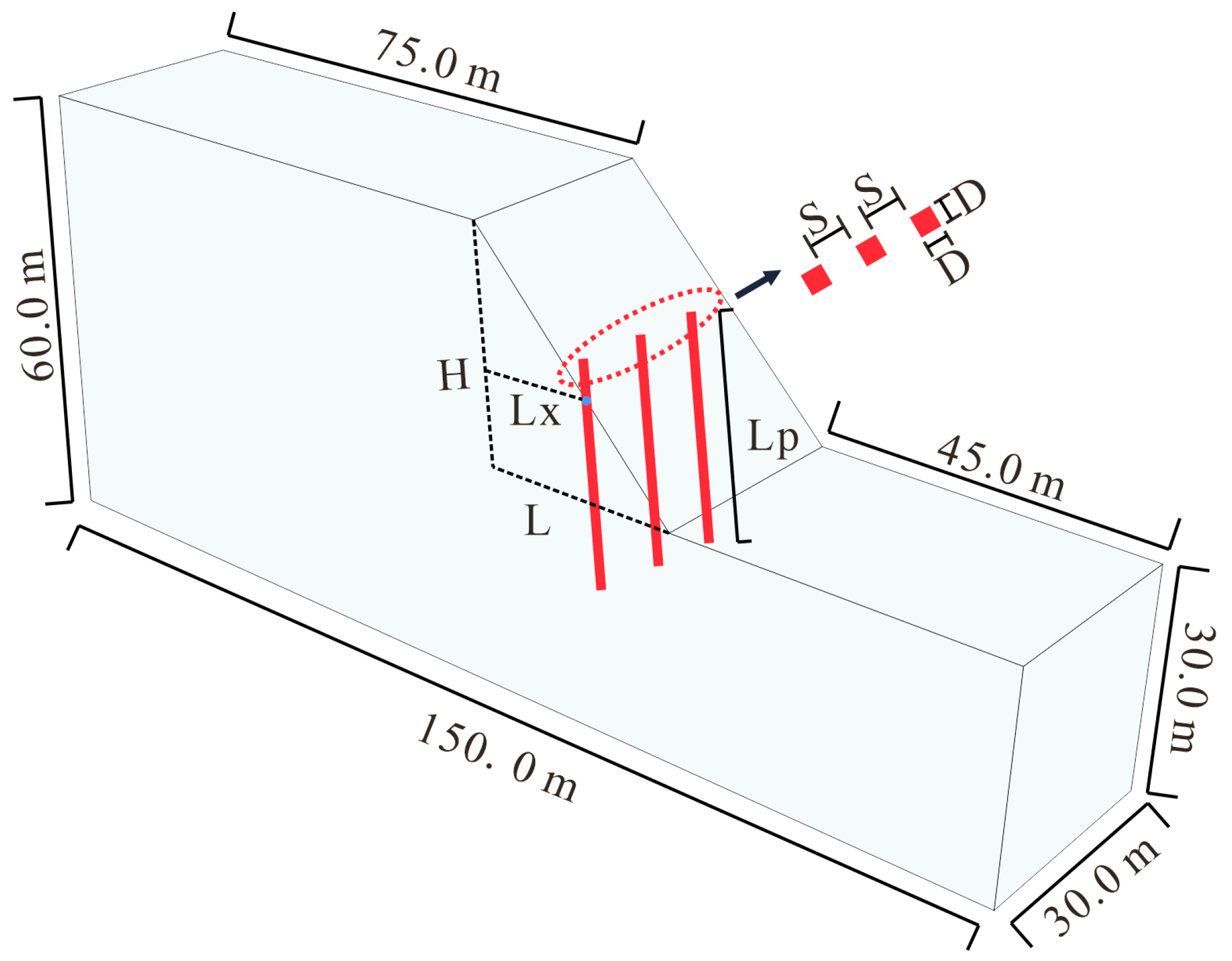
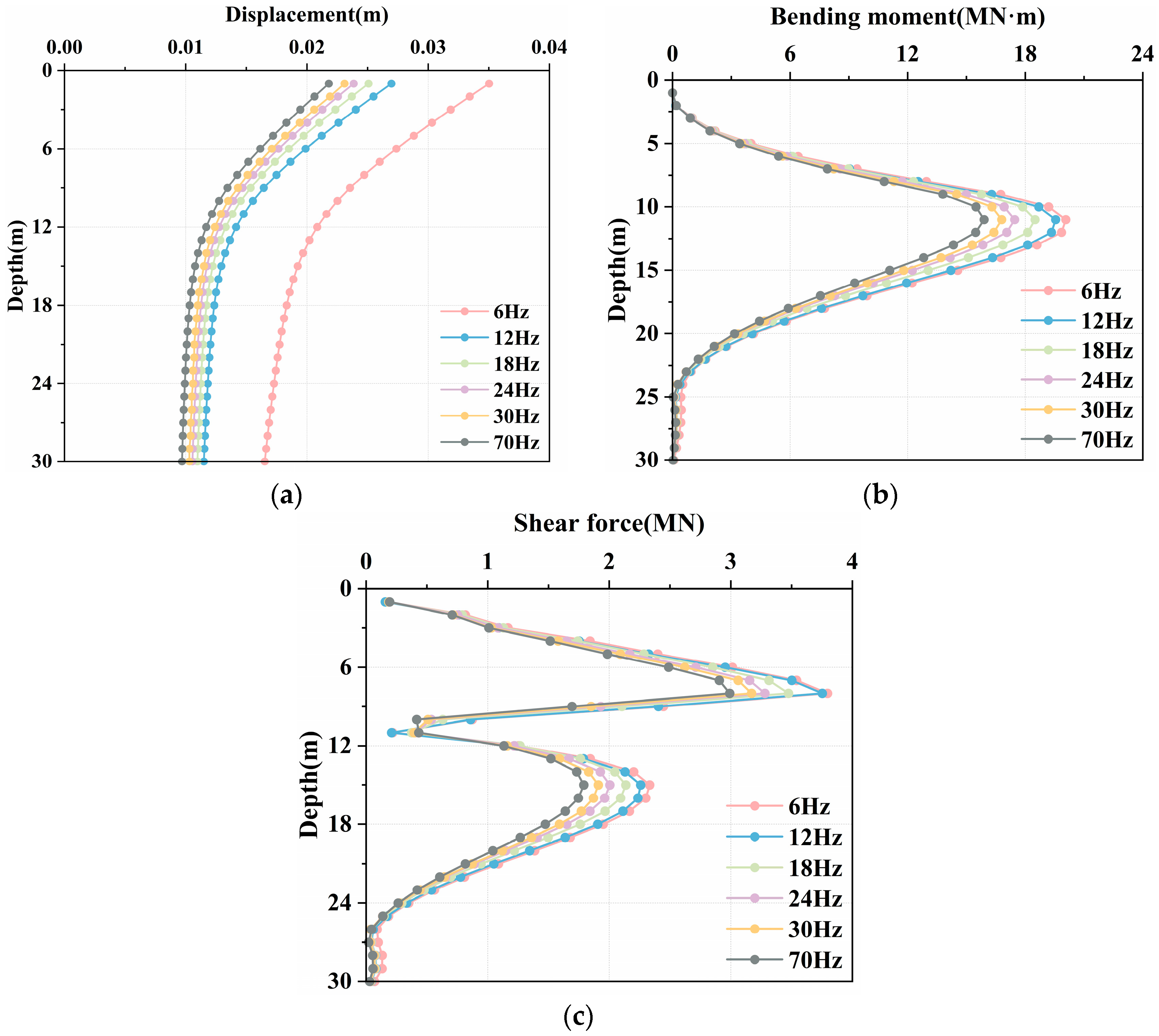
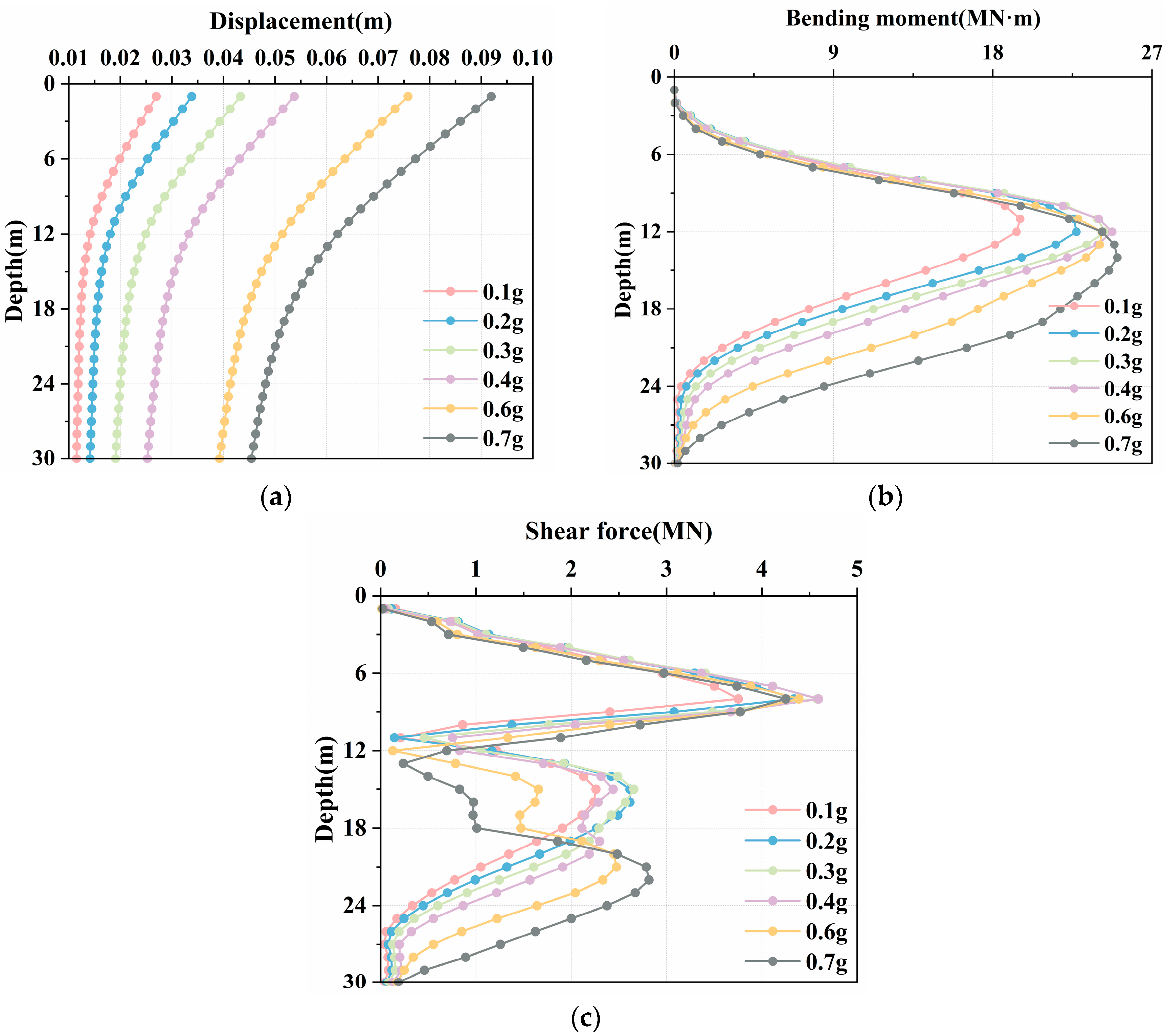
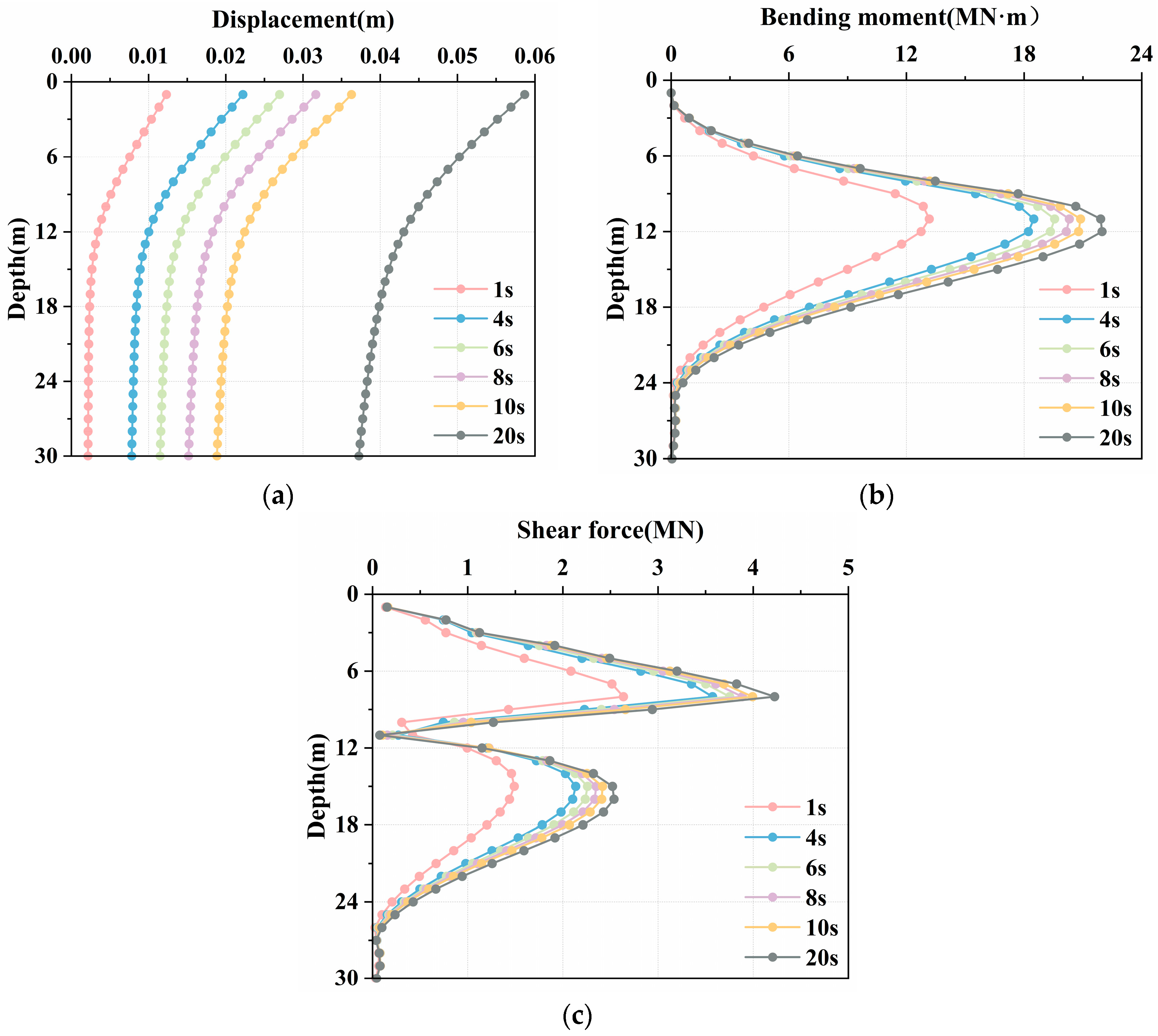
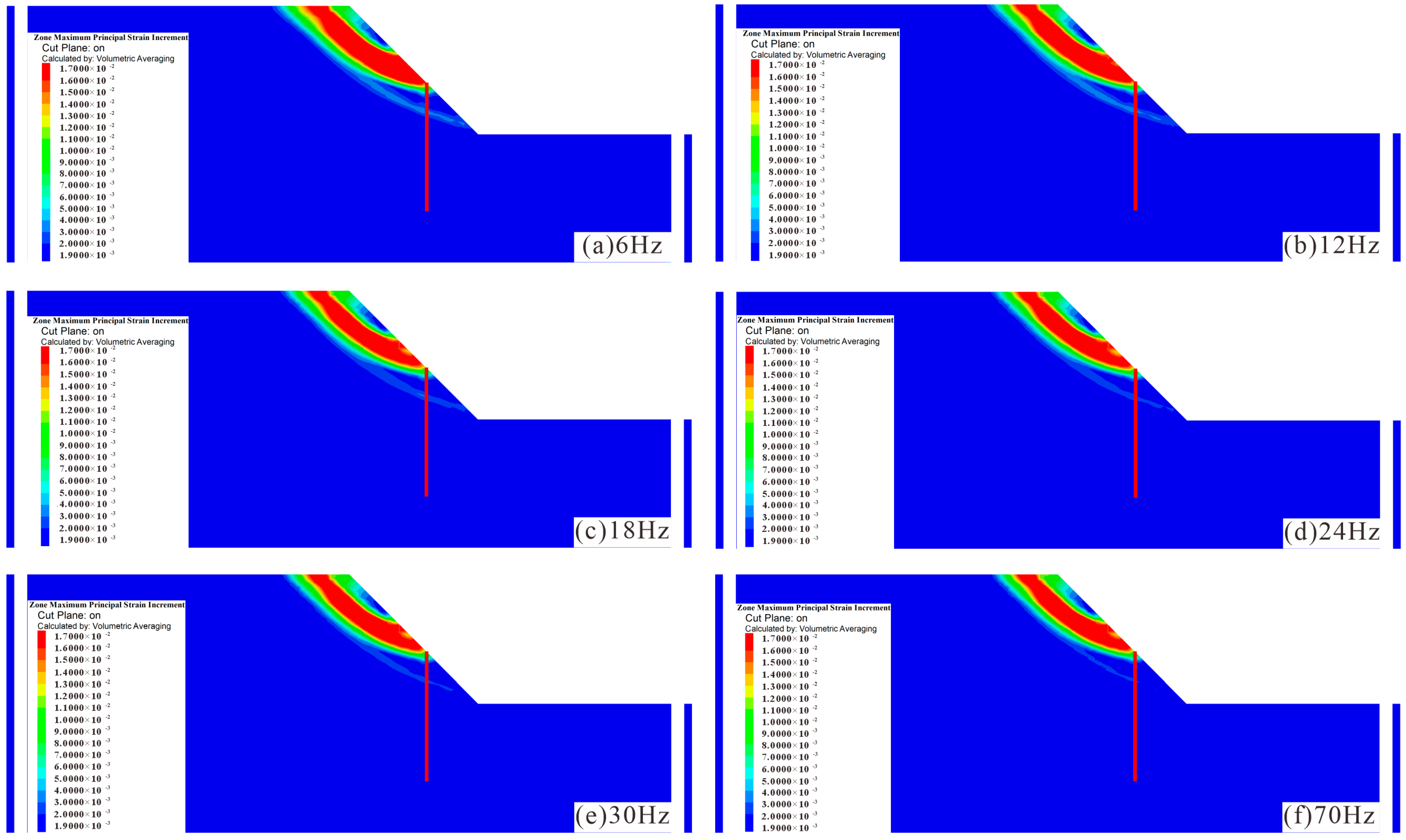
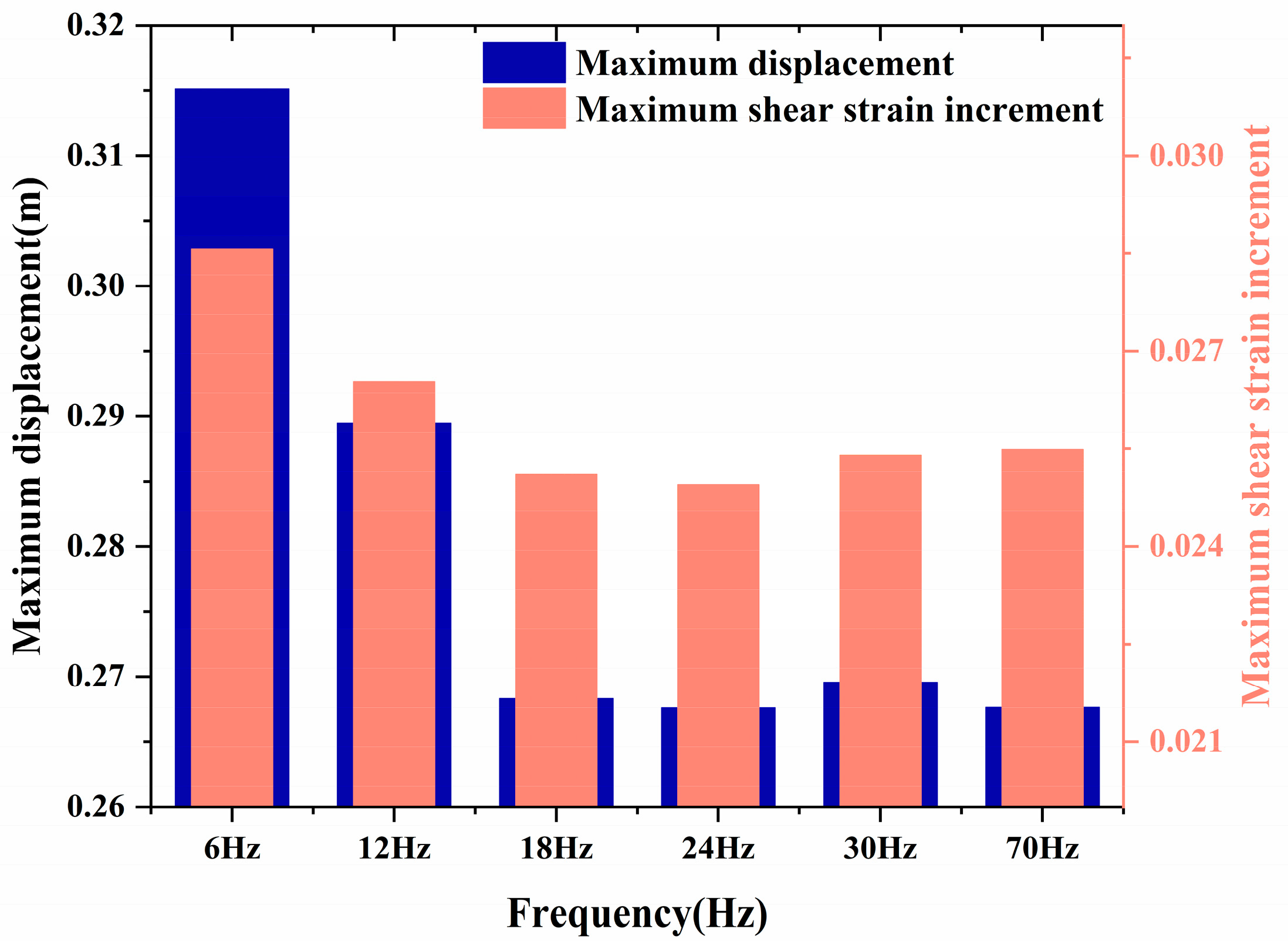
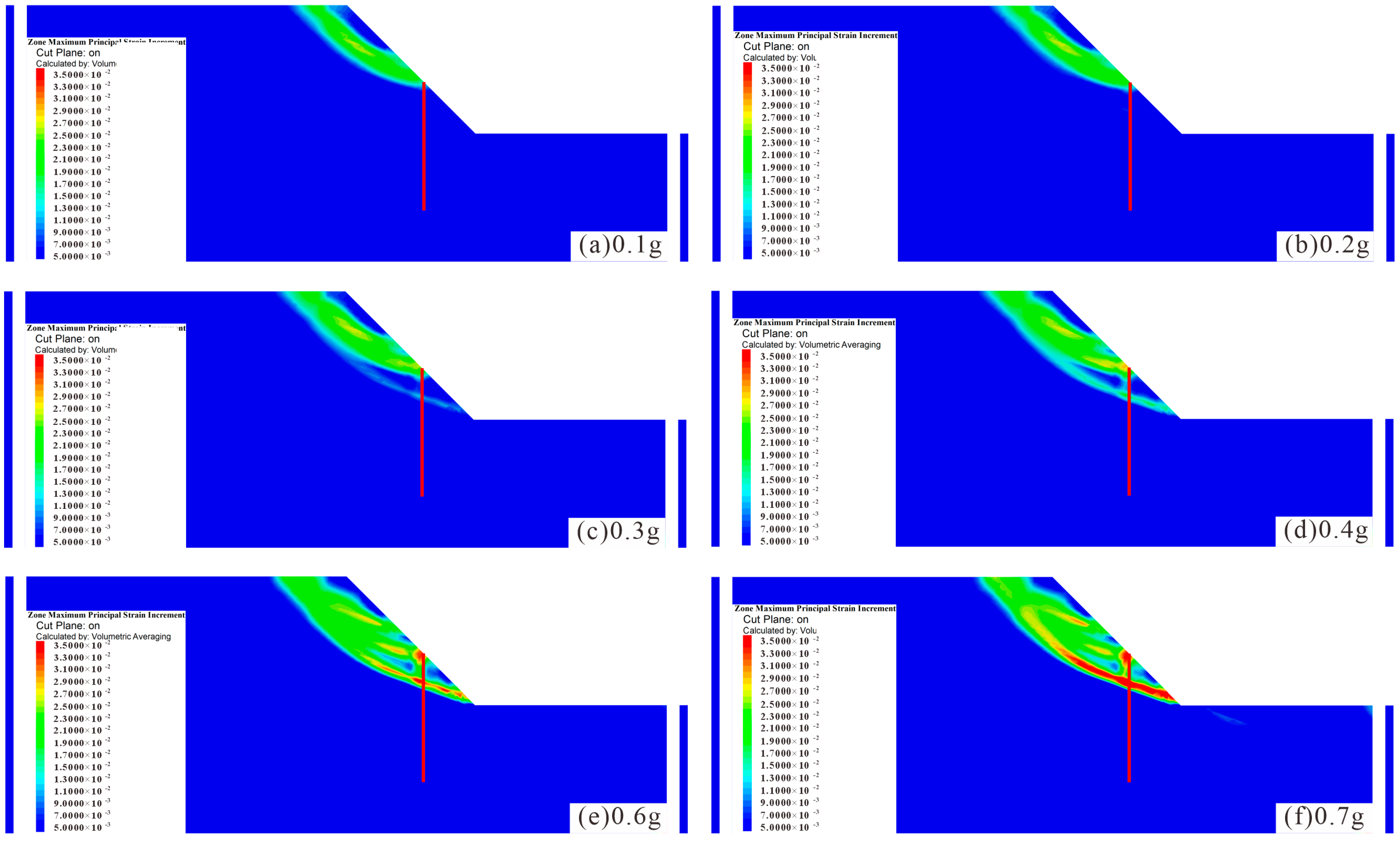
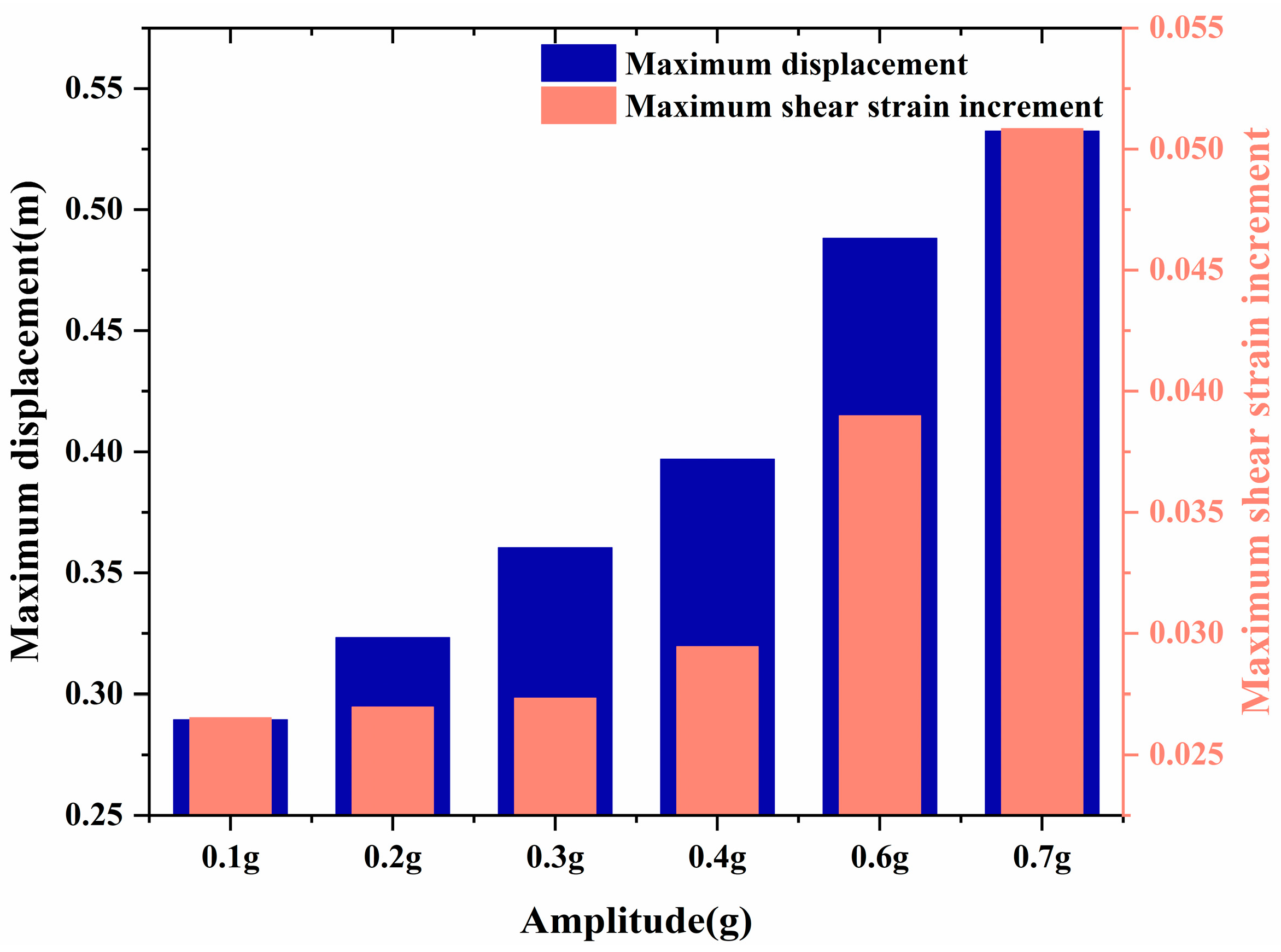
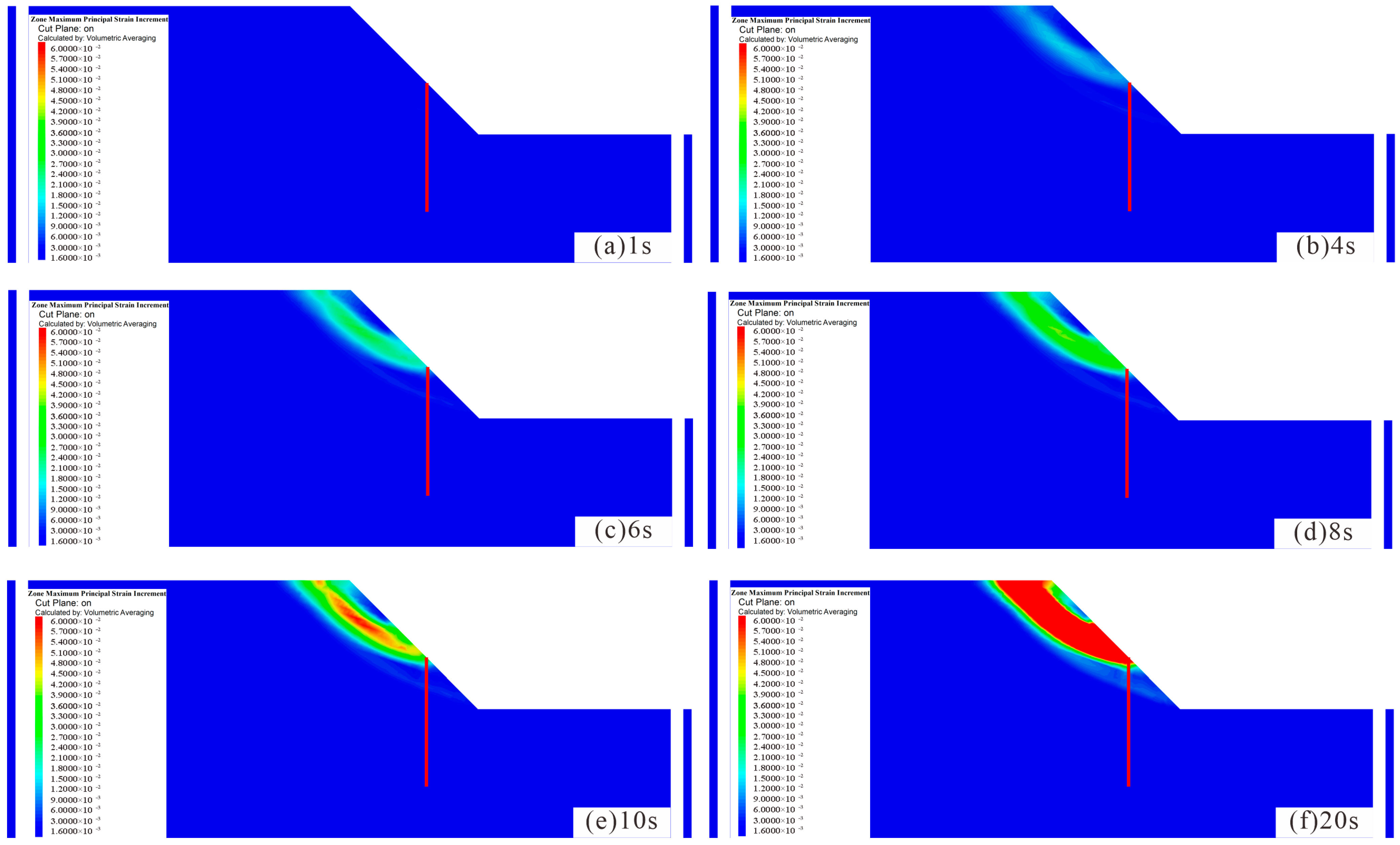
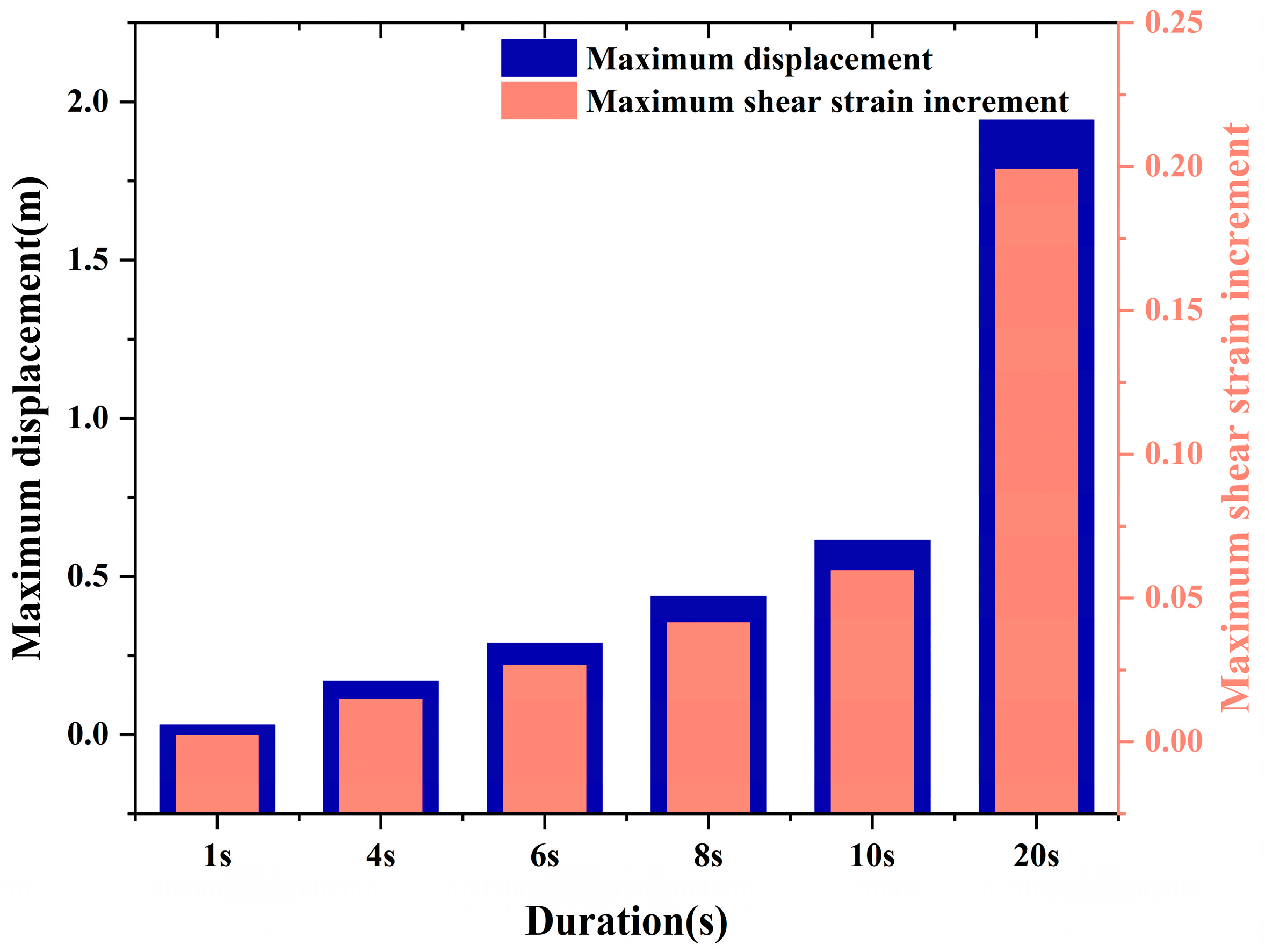
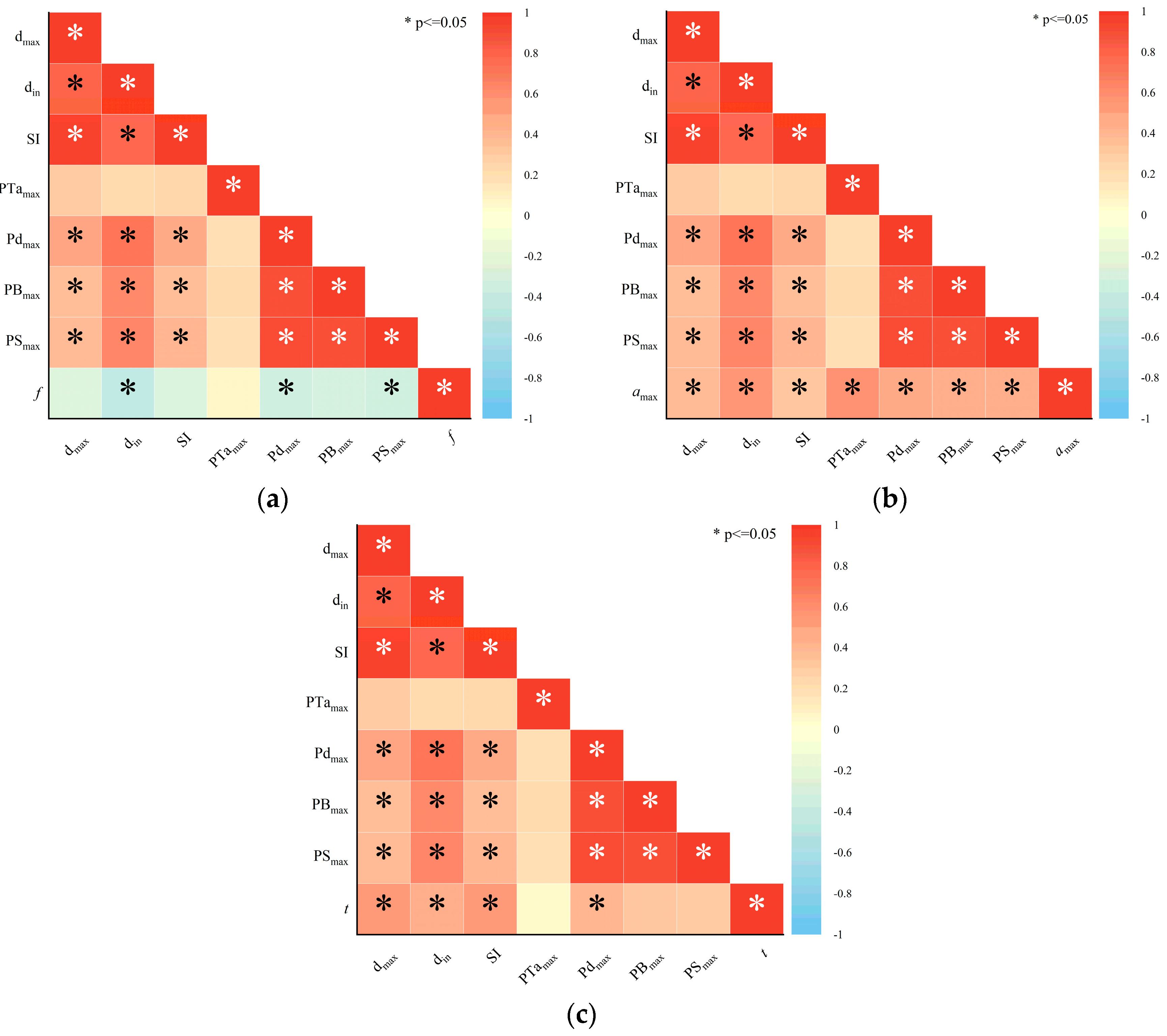
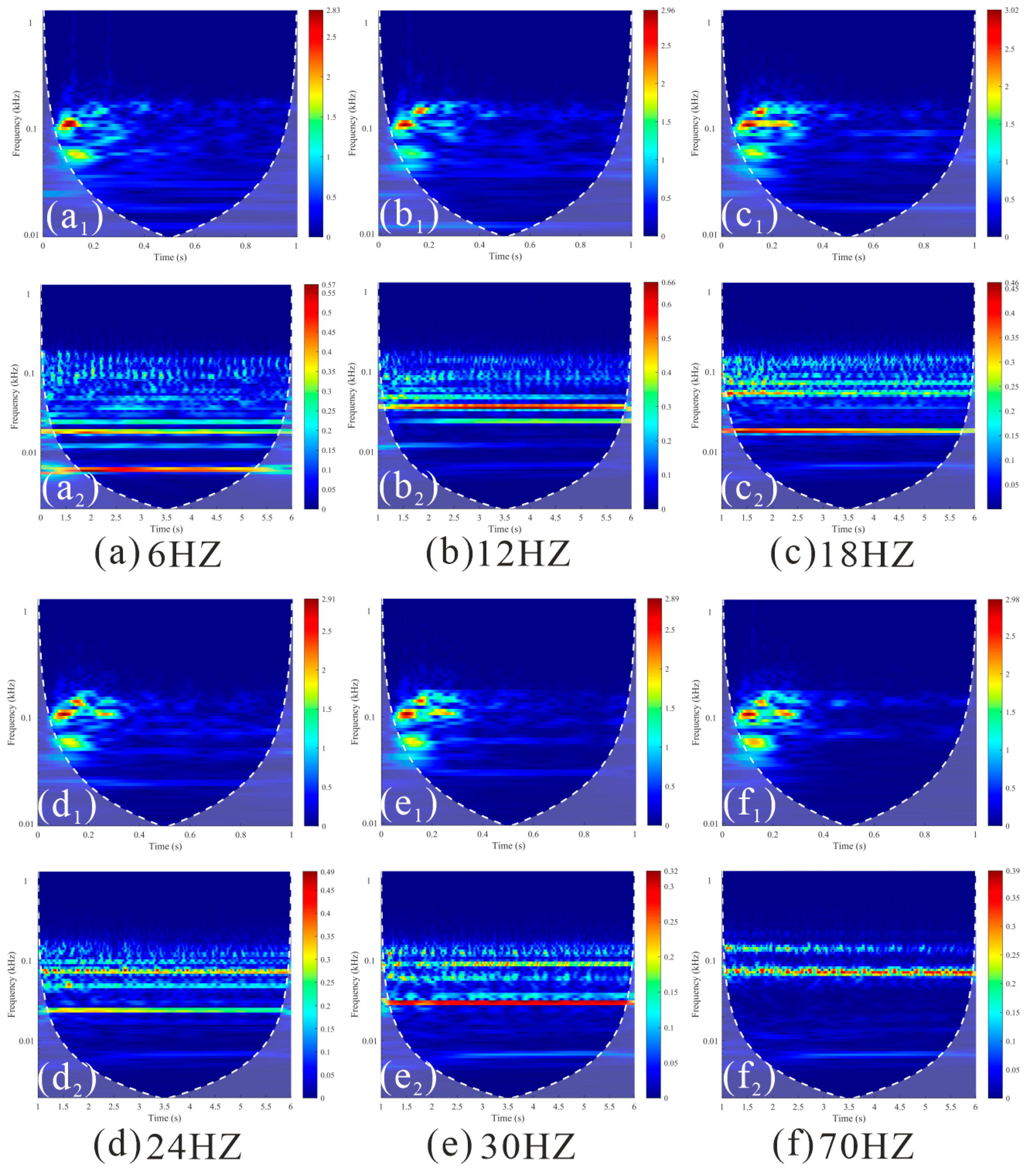
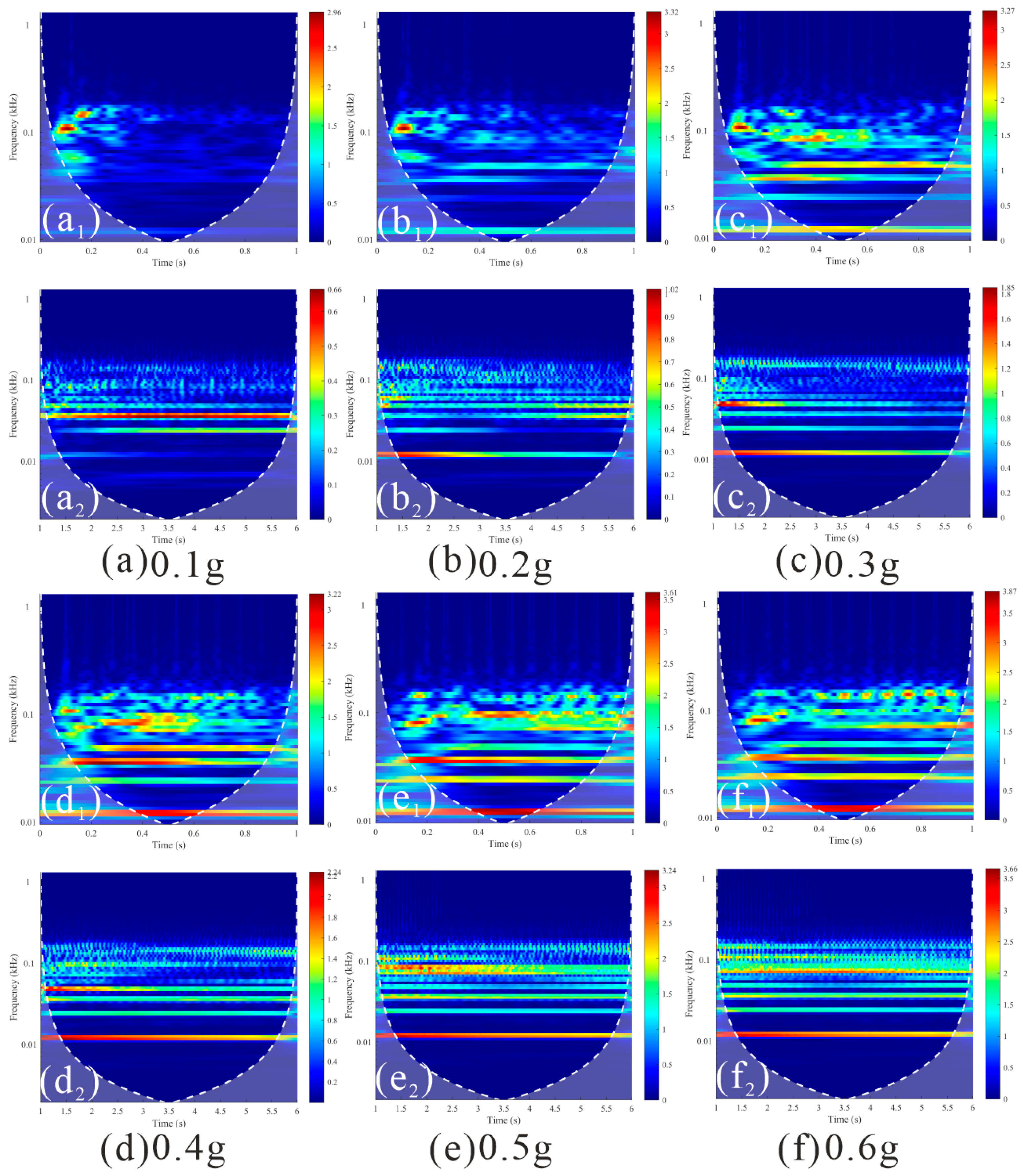
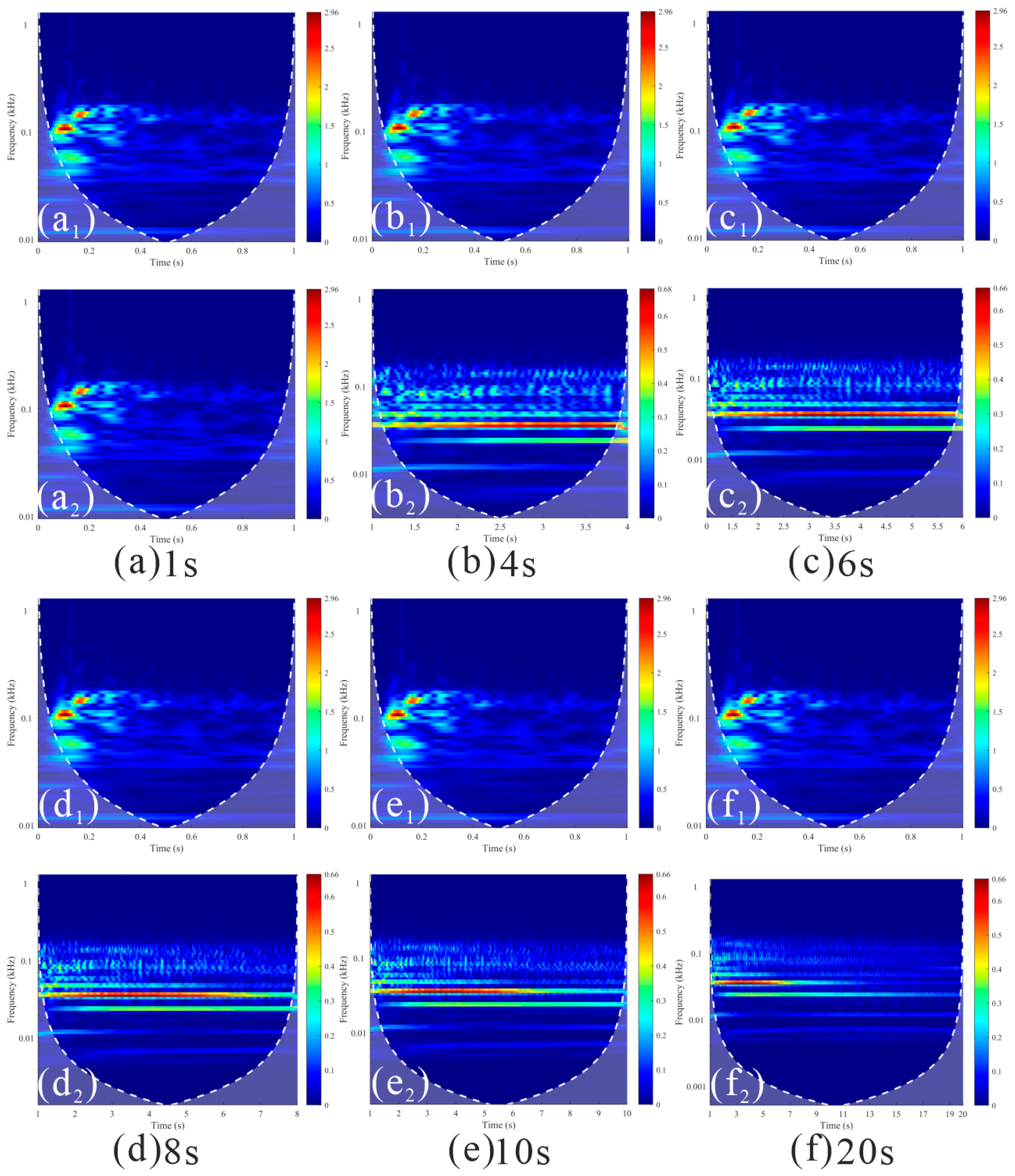
| Stratum Number | Bulk Modulus K (MPa) | Shear Modulus G (MPa) | Unit Weight Γ (kN/m3) | Cohesion C (kPa) | Friction Angle φ (°) |
|---|---|---|---|---|---|
| 1 | 256 | 169 | 20.0 | 19.8 | 21 |
| 2 | 356 | 209 | 20.8 | 21.0 | 23 |
| 3 | 404 | 247 | 21.0 | 22.9 | 26 |
| 4 | 446 | 317 | 21.2 | 23.8 | 28 |
| 5 | 556 | 367 | 21.5 | 120.0 | 33 |
| 6 | 646 | 427 | 21.8 | 140.0 | 34 |
| 7 | 3840 | 638 | 23.5 | 160.0 | 38 |
| Serial Number | amax (g) | f (Hz) | t (s) | Serial Number | amax (g) | f (Hz) | t (s) |
|---|---|---|---|---|---|---|---|
| 1 | 0.1 | 6 | 6 | 10 | 0.4 | 12 | 6 |
| 2 | 0.1 | 12 | 6 | 11 | 0.6 | 12 | 6 |
| 3 | 0.1 | 18 | 6 | 12 | 0.7 | 12 | 6 |
| 4 | 0.1 | 24 | 6 | 13 | 0.1 | 12 | 1 |
| 5 | 0.1 | 30 | 6 | 14 | 0.1 | 12 | 4 |
| 6 | 0.1 | 70 | 6 | 15 | 0.1 | 12 | 6 |
| 7 | 0.1 | 12 | 6 | 16 | 0.1 | 12 | 8 |
| 8 | 0.2 | 12 | 6 | 17 | 0.1 | 12 | 10 |
| 9 | 0.3 | 12 | 6 | 18 | 0.1 | 12 | 20 |
| Parameter | Value | Parameter | Value | Parameter | Value |
|---|---|---|---|---|---|
| Young modulus | 30 GPa | Coupling-cohesion: shear | 1.9 × 107 Pa | Coupling-cohesion: normal | 1.9 × 107 Pa |
| Poisson ratio | 0.21 | Coupling-stiffness: shear | 1.0 × 109 N/m2 | Coupling-stiffness: normal | 1.0 × 109 N/m2 |
| Moi-z | 2.0 m4 | Coupling-friction-shear | 22° | Coupling-friction: normal | 22° |
| Moi-y | 4.5 m4 | Density | 2500 kg/m3 | Coupling-gap: normal | on |
| Moi-polar | 6.5 m4 | Cross-sectional area | 4.0 m2 | Perimeter | 8.0 m |
Disclaimer/Publisher’s Note: The statements, opinions and data contained in all publications are solely those of the individual author(s) and contributor(s) and not of MDPI and/or the editor(s). MDPI and/or the editor(s) disclaim responsibility for any injury to people or property resulting from any ideas, methods, instructions or products referred to in the content. |
© 2024 by the authors. Licensee MDPI, Basel, Switzerland. This article is an open access article distributed under the terms and conditions of the Creative Commons Attribution (CC BY) license (https://creativecommons.org/licenses/by/4.0/).
Share and Cite
Li, L.; Xue, L.; Jiang, T.; Huang, K.; Li, Z. A Study on the Dynamic Response and Deformation of Slopes Supported by Anti-Slide Piles Subjected to Seismic Waves with Different Spectral Characteristics. Sustainability 2024, 16, 9623. https://doi.org/10.3390/su16229623
Li L, Xue L, Jiang T, Huang K, Li Z. A Study on the Dynamic Response and Deformation of Slopes Supported by Anti-Slide Piles Subjected to Seismic Waves with Different Spectral Characteristics. Sustainability. 2024; 16(22):9623. https://doi.org/10.3390/su16229623
Chicago/Turabian StyleLi, Longfei, Lei Xue, Tong Jiang, Kun Huang, and Zhuan Li. 2024. "A Study on the Dynamic Response and Deformation of Slopes Supported by Anti-Slide Piles Subjected to Seismic Waves with Different Spectral Characteristics" Sustainability 16, no. 22: 9623. https://doi.org/10.3390/su16229623
APA StyleLi, L., Xue, L., Jiang, T., Huang, K., & Li, Z. (2024). A Study on the Dynamic Response and Deformation of Slopes Supported by Anti-Slide Piles Subjected to Seismic Waves with Different Spectral Characteristics. Sustainability, 16(22), 9623. https://doi.org/10.3390/su16229623







